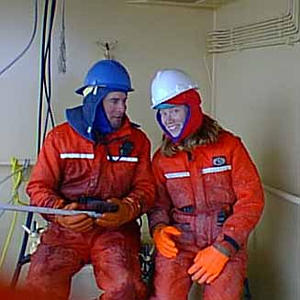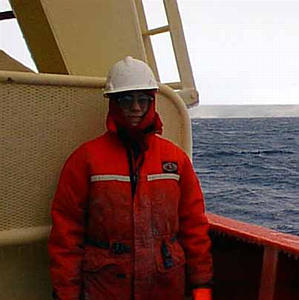1 March, 1999
March 1, 1999
Greetings from way down south! Boy, what a day! It started off with high
winds and large waves . . . that even woke me up in the middle of the
night! We changed time zones last night, so the fact that I was already
awake helped me get up an hour earlier than usual. About 10 minutes after
I started working, the fire alarm went off. It was another emergency drill
. . . but you should have seen me jump when I heard the alarm! I guess it
took me by surprise.
The seas were so rough this morning that we couldn't do anything that we
wanted to do. Rather than sit around and wait for better weather, we
decided to move closer to the land and hope for calmer seas in that area.
It worked! The height of the waves depends on three things: the wind
speed, the wind duration, and the fetch (the distance the wind blows over
the water). Since we moved back towards the ice shelf, the fetch was much
shorter so the waves were much smaller. After that, we were able to take a
piston core and then run about four hours of the deep tow! The winds are
still high tonight, and we're hoping that this storm system will be done by
sometime tomorrow. How do you suppose that storms in Antarctica are
different from those in the United States? How are they similar? We'll
look at that in tomorrow's journal.
Our question for today was: "How can there be laws that everyone is forced
to obey in Antarctica?" As you probably remember, Antarctica is not owned
by any one nation. The countries that conduct research in Antarctica have
worked together to come up with the Antarctic Treaty, which was originally
signed by 12 nations in 1961 and now includes 43 different countries. In
this agreement, countries active in Antarctica consult on the uses of the
whole continent. Specifically, the treaty includes all the area south of
60 degrees South latitude. The Treaty itself includes 12 arcticles, but can
be summarized with the following:
1) It agrees that Antarctica should be used for peaceful purposes only.
2) It prohibits nuclear explosions and the disposal of nuclear waste.
3) It guarantees the freedom of science and promotes sharing among scientists.
4) It allows on-site inspection by foreign observers to make sure the
Treaty is being followed.
5) It does not recognize, dispute, or establish territorial claims.
Although the Antarctic Treaty seems very complete, there have been many
other treaties passed since 1961 to make more specific rules about
protecting Antarctica. The most recent agreement was the Protocol on
Environmental Protection to the Antarctic Treaty. It was passed in 1991,
and it applies to all people and activities on the continent of Antarctica.
Some of the special regulations include:
1) Respect Protected Areas -- This specifies that a person may not damage,
remove, or destroy historic sites or monuments. In some places, people are
even required to have a permit to enter.
2) Respect Scientific Research --People are not allowed to interfere with
scientific research, facilities, or equipment. They are also required to
obtain permission before visiting Antarctic science and logistic support
facilities.
3) Be Safe -- People must be prepared for severe and changeable weather.
They should not expect a rescue service. Rather, they should work towards
self-sufficiency. Their clothing and equipment must meet Antarctic
standards. They also must respect any smoking restrictions and not enter
emergency refuges except in the case of emergencies.
4) Protect Antarctic Wildlife -- The taking of Antarctic wildlife is
prohibited unless someone has a permit. No person is allowed to feed, touch
or handle birds or seals. They may not damage plants. No non-native
plants or animals are allowed in Antarctica. Guns and explosives are
prohibited. In addition, vehicles (on land, air, or sea) should be used in
ways that do not disturb wildlife. Even our ship avoids ice that is
carrying seals or penguins.
5) Keep Antarctica Pristine -- People are not allowed to dispose of litter
or garbage on the land and open burning is prohibited. Lakes and streams
must not be polluted, and special rules must be followed for materials
disposed at sea. Graffiti or carving on rocks or buildings is prohibited.
It is illegal to take any geological (rock) or biological (egg, fossil,
bone, etc.) specimens as a souvenir. It is also illegal to take parts or
contents of buildings or to deface or vandalize buildings of any type.
This agreement also sets some other rules -- for example it also prohibits
mining in Antarctica. Sometimes it is difficult to get all the nations of
the Antarctic Treaty to agree to more specific rules such as these, but
they are really good for the continent and the ocean around the continent.
Antarctica is the last pristine place on the planet. I am very glad that
the people and the countries who work there are cooperating together to
protect it!
I'm looking forward to hearing some more questions soon. I'm so glad that
I have an opportunity to share all of my experiences with you. I'm really
having a wonderful time down here, and I love sending back the journals and
pictures each day!
Kim Giesting
Latitude: 73 degrees 47 minutes South
Longitude: 127 degrees 51 minutes East
Temperature: -4.2 degrees C
Barometer: 983.2 mb
Wind Speed: 47.5 knots
Wind Direction: 91 degrees (from the East)
Sunrise: 23:48
Sunset: 15:54

Steve and Ashley are waiting for the piston core to come up out of the water.

Ashley is "flying the fish." In other words, she is controlling the deep tow side scan sonar.

Kim on the back deck with the Getz Ice Shelf in the background. She is wearing her mustang suit and waiting for the piston core to come out of the water.
Contact the TEA in the field at
.
If you cannot connect through your browser, copy the
TEA's e-mail address in the "To:" line of
your favorite e-mail package.
|
